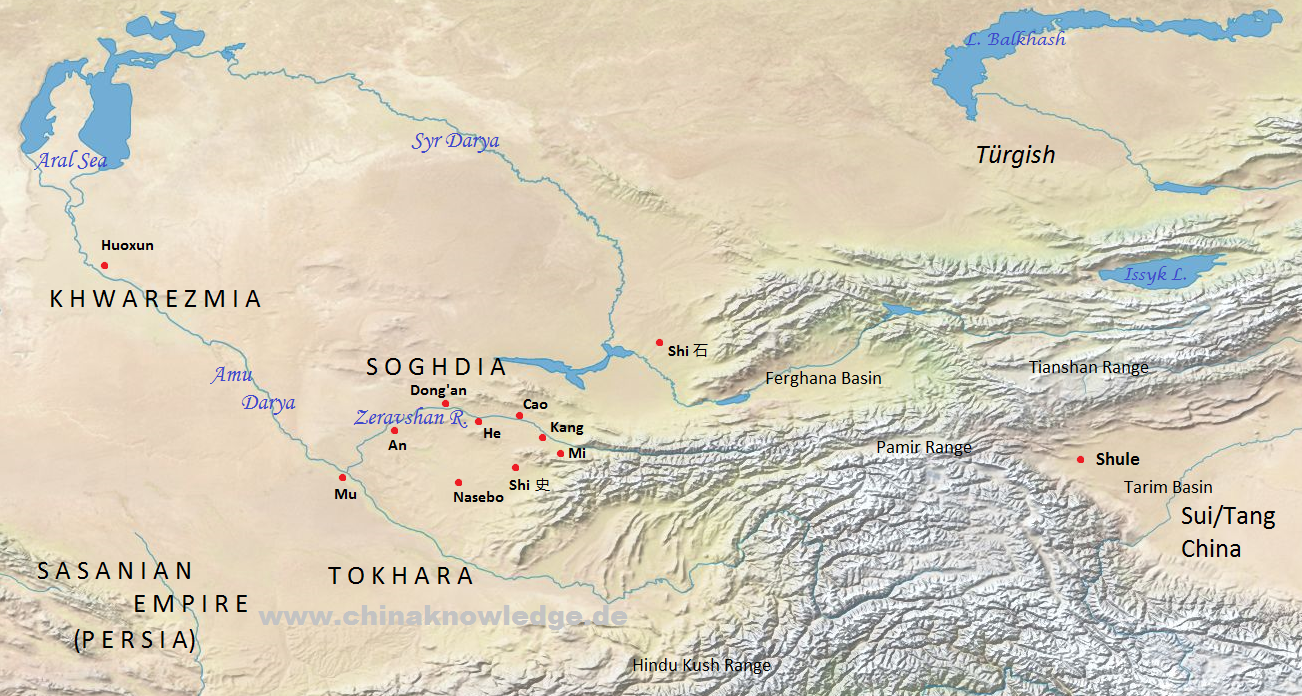The state of Caoguo 曹國 was located in the region between Ishtihan and Istaravshan in modern Uzbekistan, a land formerly known as Soghdia or Soghdiana, in Chinese Sute 粟特. Tradition says that the city was founded by one of the Nine Tribes from Zhaowu (Zhaowu jiuxing 昭武九姓). It flourished in the sixth and seventh centuries.
The state actually consisted of four city states (Eastern Cao 東曹, Western Cao 西曹, Central Cao 中曹 and Cao proper 曹). The country was also known to the Chinese as Jiebudana 劫布呾那 or Gabudan 伽不單. The country of Caoguo covered the fertile Ferghana Basin, and its capital city was located at the banks of a river called Nami 那密 (today called Zeravshan, in Chinese Zelafushan 澤拉夫善河, a tributary of the Amu Darya). The region was formerly controlled by the state of Kangju 康居, and in the early history of Caoguo, the king of Kangju (later Kangguo 康國) dominated the main city of Caoguo. The latter was considerably small, with no more than just over 1,000 inhabitants. The people of Caoguo were known as good dancers and singers, but were also active as merchants travelling along the Silk Road. They believed in a deity called Dexi 得悉神. The earliest tribute missions to China were sent during the Sui period 隋 (581-618).
 |
The Soghdia around 600 CE. Based on Tan Qixiang 譚其驤, ed. (1995), Zhongguo lishi ditu ji 中國歷史地圖集, Vol. 5, Sui, Tang, Wudai Shiguo shiqi 隋唐五代十國時期 (Beijing: Zhongguo ditu chubanshe, 1996). |
The capital of Eastern Caoguo, Suduishana 蘇對沙那, was built on the relics of the former city of Nishi 貳師, capital of the country of the Dayuan 大宛.
In 742 the king of Eastern Caoguo, She'ahu 設阿忽, asked the court of the Tang empire 唐 (618-907) for support against the Muslims that had invaded Central Asia. King Gelopuluo 哥邏僕羅 (also written 哥羅仆羅) even offered tributes to the Tang and was by Emperor Xuanzong 唐玄宗 (r. 712-755) given the title of King Huaide 懷德王.
Caoguo was never made an indirectly administered prefecture (see jimi system 羈縻) in the Protectorate of the Pacified West (anxi duhufu 安西都護府). In 751 the region was occupied by Muslim indavers.